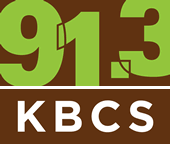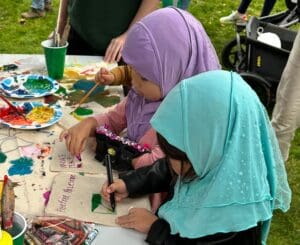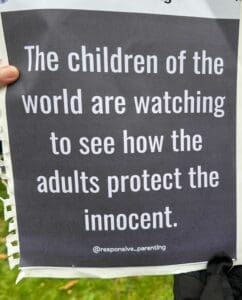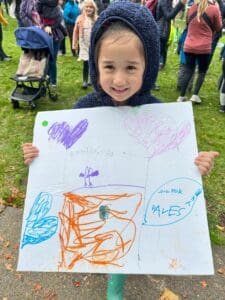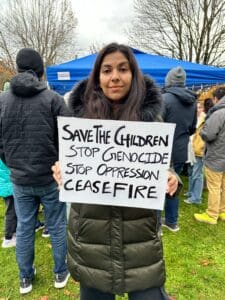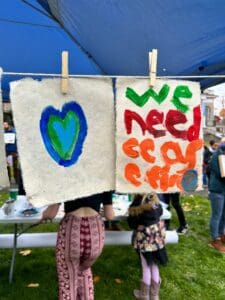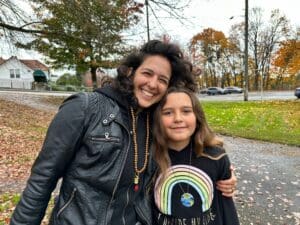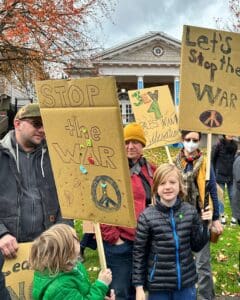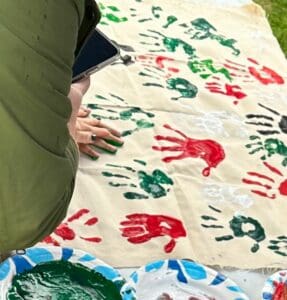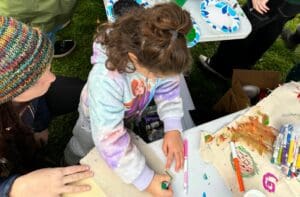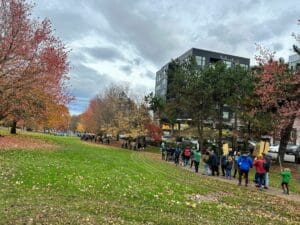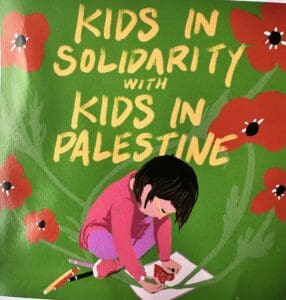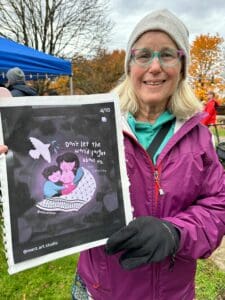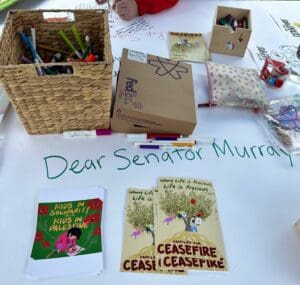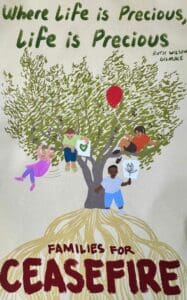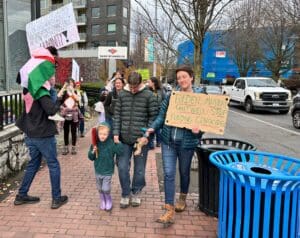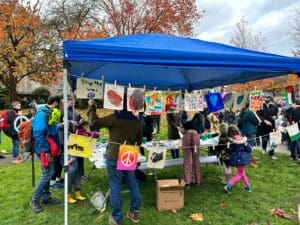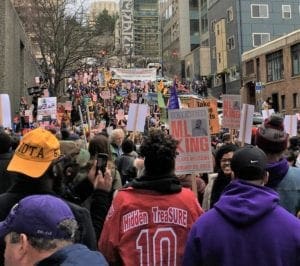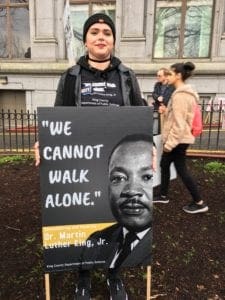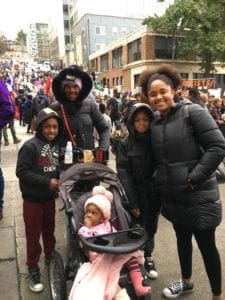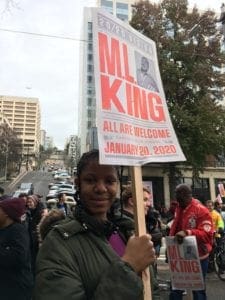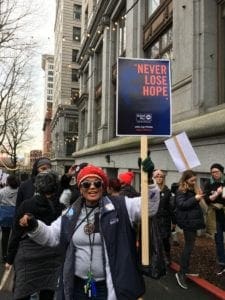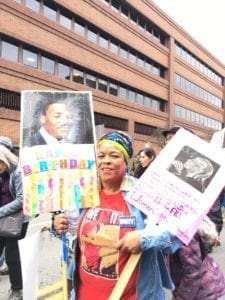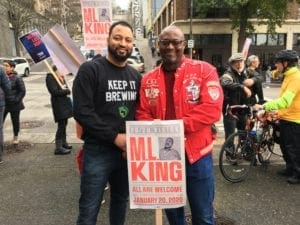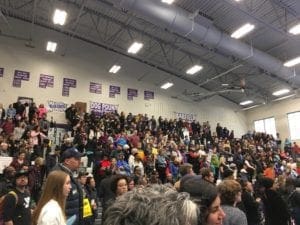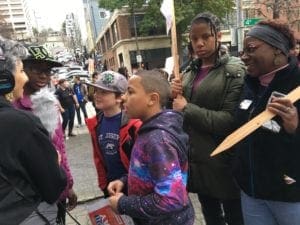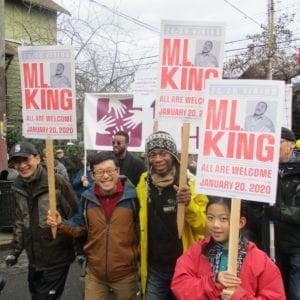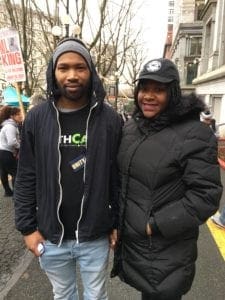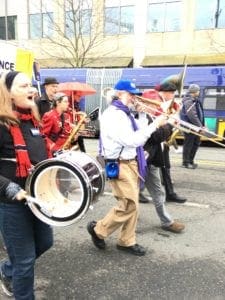Families in Solidarity with Palestine
In Gaza, Israeli attacks have killed 8,000 women and children (70% of fatalities). Today, the two largest hospitals in Gaza have stopped functioning as they’ve run out of fuel and are surrounded by Israeli forces.
Meanwhile, yesterday, 300-400 hundred people gathered in Seattle’s Columbia Park for a Ceasefire march around the block and rally for families and children. Participants sang songs, painted murals and prayer flags for Palestine, and wrote postcards addressed to state elected officials to demand a ceasefire.
Listen to some sounds and voices from the event. You may hear the rain in some of the clips.
A longer highlight of this event will broadcast tomorrow on KBCS during the Grit at 7 am.
Producer: Yuko Kodama
Photos: Yuko Kodama
second row – Miwa Nietering (age 6), Nazia Siddiqi
third row – Rose Waterstone and Cypress Waterstone (age 10)
fourth row – Loren, Zachary, Theo, Tony and Didi; mural of handprints
sixth row – the march was around the block
seventh row – Macy Ratliffe “Don’t let the world forget about us. Free Palestine”
eighth row – table to write post cards to Washington state elected officials
ninth row – artwork by Ruth Wilson Gilmore
tenth row – art tent to contribute to the mural and to create prayer flags
Martin Luther King Jr. Day – Seattle March
Thousands took the streets in Seattle on Monday for the 38th annual Martin Luther King Jr Day March. KBCS’s Gol Hoghooghi and Yuko Kodama gathered sounds and interviews from the celebration.
The Crack Epidemic’s Impact on Black Communities
Crack cocaine, swept throughout the US in the 1980s as an inexpensive and easily accessible drug. Neighborhoods and families were severely impacted by this epidemic. Aaron Dixon, the former Seattle Chapter Captain for the Black Panther Party, is writing a book on the impact of crack cocaine on black communities. Dixon describes how large amounts of cocaine began streaming through the US in the 60s and 70s due to U.S. government actions. He also recounts his personal experiences in trying to keep gang-involved youth alive and afloat at this tumultuous time.
Photo courtesy of blackpast.org
The Crack Epidemic and Its Impacts on Black Families
Yuko Kodama 0:00
You’re listening to 91.3 KBCS. This is Yuko Kodama, I interviewed Aaron Dixon, who is the former Black Panther Party, Seattle Chapter captain. He wrote the book, “My People Are Rising.” And more recently, he’s been finishing a second book. I spoke with Aaron Dixon earlier this month about the book he’s working on now. You had written, “My People Are Rising” and tell me what’s in your second book.
Aaron Dixon 0:29
My second book, well the – the working title is “Journey Through The Black Underground;” Ronald Reagan, crack cocaine, gang epidemic, destruction of the black family and the black community. And that’s what I explore – is the beginning of the 80s because I think the beginning of the 80s really exemplifies where we’re at right now. Of course, it didn’t begin with Ronald Reagan. It didn’t begin in the 1980s. Before Ronald Reagan in the 80s, there was a lot more possibilities that we could really create a more just society and a just world coming out of the Vietnam War, the impeachment of Richard Nixon, and coming out of the whole movement of the 60s and 70s… and all the things that the Black Panther Party did and all those movements of the 60s did. Unfortunately, Ronald Reagan was elected as president, and Ronald Reagan was the beginning. It was the beginning of a lot of things with Ronald Reagan was elected. Before Ronald Reagan we didn’t have large amounts of homeless people – we very rarely saw any homeless people. We had a level of socialism that existed in our society. College tuition was much more affordable because the wealthy we’re being taxed to pay for a lot of that college education. You know, our medical mental health system was still intact.
What I wanted to do is explain and lay a foundation to young people. To explain how we got to where we’re at right now. You know, one of the first things that Ronald Reagan began to do was he cut the mental health funding, almost in half or more than half which, you know, people who are mentally ill, they need help. They need a place to go. They need a place where they could live and sleep and get the help and the care that they need to get. And when you can’t provide that – when you as a society cannot provide for the mentally ill. You’re really laying the foundation for a failed society. And that was the beginning of what we saw what Ronald Reagan did, by slashing the funding for mental health that put thousands and thousands of mentally ill people out on the streets today. And as a matter of fact, a lot of the people who are in prison are mentally ill, because they have nowhere else to go. So they’ve ended up in prison, but by putting a lot of them out on the streets, you had a lot of things that happened to them, as well as things that they did to other people, you know, there were people that were killed and murdered by the mentally ill, because we weren’t willing to take care of them. He also slashed the funding for HUD. Not in half, but damn near in half, you know, subsidized housing was slashed under Ronald Reagan. And then of course, you know, the war on drugs really began with Richard Nixon. Richard Nixon laid the foundation for the war on drugs. There were a lot of black men that were arrested in the 70s.
And we started to go into our prison reform in the later part of the 70s. So it looked like you know, there would be some reform, and so many people wouldn’t be going to prison. Also, in Nicaragua, we had the Sandinistas who forced Samoza out of power, who was one of the most brutal dictators in South America, who got a lot of funding and a lot of support from the US government. And Ronald Reagan became so alarmed with Samoza being pushed out of office and that fear and paranoia of communists spreading throughout South America, you know, created this thing where we started funding a counter-revolutionary group, the Contras. Oliver North was involved to try to get funding to the Contras. Congress said that they weren’t going to fund it. So what did they do? The CIA turned to the Nicaraguan drug dealers who had been big time drug dealers in the 60s and 70s, who were also responsible for bringing a lot of cocaine into America, and so they began to use those drug dealers to import cocaine into America to raise money for the Contras to have this counter-revolutionary war against the Nicaraguan government and the Nicaraguan people who had fought and died to create a better society in their country. And so, you know, millions and millions of pounds start finding its way into America.
Now, this wasn’t the first time that the CIA was involved in drug dealing. The very first time that the CIA began to get involved in drug dealing was during the Vietnam War. When there was a General Pao, who was the General in Laos, who was the kingpin drug dealer in Southeast Asia, the CIA became partners with him. First of all, they started giving him planes to be able to export his heroin around Southeast Asia. And then the next thing they did was introduce him to Gianconfe, one of the leaders – leading mobsters in New York. They connected him with General Po, and that’s when they began, the mob began to import heroin into America. And you saw a devastating effect of this heroin that came into America in the 60s, particularly was coming into New York and created a heroin epidemic.
You even see “The Godfather,” alluding to this in the movie, the first “Godfather,” you know, when Marlon Brando played the role, and he said, “Well, you know, we don’t want the- heroine is dirty. We don’t want that.” And then when the other Mobsters said, “we’re just going to give it to the n****rs”, that’s what he said, and so that was the first time the CIA brought heroin into America. And what that did then was it created a whole epidemic of heroin addiction and crime, which began this war on drugs by Nixon, they began to put more black people in prison. So here it is, 10 years later, under Ronald Reagan, they’re importing all this cocaine into America. And at the same time, you have his wife saying, “just say no to cocaine”, and it’s – it’s proven that Ronald Reagan, Bush no one, were involved in this, and Bill Clinton, were involved in this cocaine coming into America. And at first it was going to LA because in LA there was a man who was a businessman in Nicaragua. He was a sympathizer of the Contras, and he wanted to raise money for the Contras. So the CIA contacted him and asked him to work with him. So they were shipping him millions of pounds of cocaine into America. But he needed an outlet. And it just so happened that he found an outlet – this young man named Ricky Ross, who was a black – all this is in the “Dark Alliance,” a book by Gary Webb, called “Dark Alliance” and he researched this for over 10 years.
Now, Ricky Ross was a young black man who wanted to be a tennis player. He played tennis in high school. When he got out, he tried to get into college, but he couldn’t because he couldn’t read or write. So he went to trade school, and he met this black guy who was selling just a little bit of cocaine here and there, you know, because in the 70s, cocaine was a casual drug. Everybody was snorting it; Hollywood people, Congress people, everybody was snorting – it was a casual drug. But the more money you had, the more likelihood that you would get addicted to cocaine. And so when you have so many people using a drug like that, then people started experimenting with other ways and they get more access to more pure cocaine. And so, you know, first you had to powder cocaine, and then you had this thing, that people who had money started to smoke the pure cocaine, which was called “rock” – you know, like a big pure rock of cocaine. The Rock cocaine became popular, but you had to have more money to smoke that rock because it costs a lot of money. Okay, so Ricky Ross, he starts selling rock cocaine. But Ricky Ross, he’s smart, he knows how to market. So he sees how people are buying this coke, he said “Well, we got to make it more affordable for the average person.” So they come up with this method of cooking it down to this little small packages of 10 – 20 dollars a package. This is the crack now we’re talking about crack, it went from powder to rock, who was for the rich people, to crack to for the average person. It’s more addictive than anything that anybody has ever seen. I mean, people will come buy it and 10 minutes later they come back buy some more. It just like kept going and getting growing and growing bigger and people came more addicted and more addicted and he opened more crack houses and the gang see this and gangs have always been territorial. The gangs weren’t about making a lot of money. You know, they were doing small time hoodlum crimes, you know, and they were more concerned about their territory and different things like that. But when the gangs saw how lucrative this business was, they got involved. And the thing about it is this drug is so addictive, that people would do anything to get some more crack. And, you know, black mothers have always been the most maternal, because they had to take care of the slave masters kids. They were used to take care of other people’s kids. When slavery ended, they had a chance to take care of their kids. And so they were very – black mothers were very maternalistic. But when they used crack cocaine that maternalism went away.
And so people became highly addicted- I mean, everybody was getting addicted! Mothers, fathers, aunts, uncles, grandparents; everybody is getting addicted under this crack. And the gangs, they’re making lots of money, but also it creates more violence. Because not only is cocaine coming into the country – into LA, specifically at this moment – but also a lot of guns and weapons are coming in by the CIA. I was in Oakland when crack cocaine hit. I was there. I saw what happened in Oakland when crack cocaine came. I saw the destruction that it did to families, to businesses, black owned businesses. You know, the other thing that was happening in the 80s was this materialism, this extreme materialism that people really didn’t care that much about in the 60s and 70s. Everybody wasn’t so consumed with wealth, but in the 80s it was all about money. It was all about getting your money, you know, and you had black athletes for the first time getting million dollar contracts and, you know, 10 million – you know, Michael Jordan, then you had, you know, you have Michael Jackson. And so materialism and money, it took over people’s minds in the 80s. And so, you know, I remember being in Oakland, I remember school teachers were selling cocaine because they wanted to get rich they want to have money too! So everybody was either selling cocaine, or they were using it.
I think all that the black community has gone through. We got to give ourselves some props that we – we survived that first of all, but that we are able to rise up above that, you know, and do better. And being able to overcome and producing a lot of great young black people. I mean, right now, black entertainers are in demand. Black filmmakers are in demand, creating some of the best films that have ever been made. black actors are in demand. And so the fact we may not be this solid group that we were in the 60s and 70s, we are dispersed and spread out in a lot of different avenues, but we have been able to rise above. You know, I’m thinking about the movie, “Moonlight,” that won an Academy Award – that was an extremely beautiful movie, and the fact that “Black Panther” is one of the highest grossing movies of all time. You know, we gotta give ourselves some props. We got to give ourself some props.
Yuko Kodama 14:57
That was Aaron Dixon, former Black Panther Party Seattle Chapter Captain. You’re listening to KBCS independent radio.
The Crack Epidemic’s Impact on Youth
Yuko Kodama 0:00
This is 91.3 KBCS listener supported radio. I’m Yuko Kodama. Aaron Dixon is the former Black Panther Party Seattle Chapter captain. After his work in the Black Panther Party, he continued on to work with youth in the Seattle Public Schools. He spoke with me about the drug epidemic during the 80s and 90s and its impact on Seattle youth. He starts by describing when and how youth gangs became prevalent in our region.
Aaron Dixon 0:28
When I was growing up, we had these superficial gangs, you know, we had names and we carry switchblades. And, you know, we fought mock battles with each other, you know, it was nothing serious. But the first black kid to get killed by another black kid in Seattle was in 1980. And before that, there were no gangs in Seattle. But the Crips came up to Seattle, so in defense, the kids in Seattle, had to create their own gang, a guy from Chicago, he was with the Black Gangster Disciples in Chicago, and he created the Black Gangster Disciples in Seattle, and they became the rival to the Crips and Bloods in Seattle and so you had this whole neighborhood warfare going on. And in 1990, Seattle started Seattle Team for Youth, which they hired all these people to work as counselors to work and all these gang counselors to work and all these different neighborhoods to try to fight against the gangs. And I got one of those jobs and I started working with young people in West Seattle, who were gang involved. So I’m raising my kids, as a single parent, and I’m also as a gang counselor, I’m working with all these young people who are in gangs, you know, and a lot of other, my fellow workers are also working with gangs. And we were trying to, you know, save as many young people as we could. Now, prior to 1980s, black kids did not go to foster care. Because we had such a strong community that if kids were homeless, there was always somebody that was going to take that child and there was always a family member that was going to take that child in. By 1980s. black kids have flooded the foster care system. Because the family and the community broke down.
And as a result of that, you know, these kids are traumatized. These kids have gone in the foster care system, they become traumatized, because a lot of those foster cares only care about money, it was it was it was pretty crazy. You not only had black families who were fleeing LA, who are bringing their kids to Seattle, to get away from the gangs. And bam, they get to Seattle, the gangs are here. The gangs are in Seattle. And a lot of the kids I worked with in Seattle, they had came from LA, because the parents are trying to get him away. So now they get game involved in Seattle, I had about 15-20 kids on my caseload and we were all trying to figure out how to work with these kids. You know, we really didn’t know exactly how to go about doing what we were doing. There were eight kids that I work with there on my caseload that were involved in homicides. We talked about 15, 16, 17 year old kids involved in homicide, they almost all of them brought guns to school, so I could either turn them in, and they would get expelled because the school had a zero policy. So what I say it was, “okay, when you bring your weapons to school, you got to come and turn them into me.” And that’s what they did. They came into my office in the morning, open up the file cabinet, they put all their guns in there and after school they came and got them, you know, because I had to build trust with them too. And I couldn’t tell them what I was gonna tell “don’t carry no guns. You can’t bring no gun to school.” They’re not gonna listen to me. Because you had gang warfare going on. They had to protect themselves and defend themselves. And so that’s the only way that I could keep them in school. And make sure they graduated.
One of the kids that I had on my caseload was a young man named Jeremiah Boucher. Jeremiah was a very smart young man, very intelligent, he was computer literate, when nobody else was computer literate. He came from a middle class family, grandparents, from Africa, but his father left and went back to Africa, his mother had to raise three kids by herself. So his older brother was gang involved. His older brother tried to rob a store in High Point in West Seattle. And he shot the store owner. And, and he, the store owner testified against him. Now, Jeremiah, I’ve been trying to get him in my group. But you know, he’s one of these smart kids, the smart, really smart kids, they’re not so apt to like, come into a group, you know, a gang intervention group, you know. And so I was, I just was getting ready, I just, he just started coming around, you know, he had his own car, 14 years old, he’s got his own car, he’s a short little guy. Ballet, you know, he took ballet, everything, just really smart. He started coming by and being inquisitive and everything. “Yeah, Aaron I’m gonna start coming to the group” and everything. And his brother gets sent to prison, because this Ethiopian store owner testified against him. Now Jeremiah, in his mind, he thinks, “okay, I have to get revenge on this guy for testifying against my brother.” So he goes in to the store, and kills the Ethiopian store owner. And became, he becomes the youngest person in state of Washington, sentenced to life in prison. So, you know, this is the type of stuff that was happening, you know, there was there was just a total breakdown in the family, total breakdown in the community, not a not a total breakdown in the community because people in the community are trying the best that they can, to try to do that. There are a lot of people in the community did step up, you know, like, the football coaches, baseball coaches, and, you know, other sports, you know, they would bring kids in, some of them would take the kids home, and, you know, everybody’s trying to, you know, save our community, it just had a devastating effect. And this went on up until the 2000s. And it was a breakdown of the family to break down the community. But it was all reinforced by Ronald Reagan.
Yuko Kodama 7:25
When you were working with the youth, what were you seeing as things that seem to resonate with people?
Aaron Dixon 7:32
Well, I was going through some things myself, you know, and I started doing affirmations, I started reading books about positive thinking, about affirmations, and creating affirmative things to say, you know, that made me feel better, and made me feel that I could achieve things. And so I started using that on the second group of kids that I worked with. And so this was the sharpest alternative high school, and we’re still heavily gang involved, these kids are bringing guns to school every day, all the kids are, almost all the kids were gang involved, and you know, and I was working with a lot of different kids, Filipino kids, mostly black kids. And so one day, I decided that I was going to introduce him to affirmations. And I didn’t know how it would come off. I didn’t know if they would laugh at me. And so “Aaron, this is silly, this is stupid, we’re not going to do this.” So I did, I asked the principal, to give me a class, once a week that I could have once a week for my kids, and the teachers were reluctant. They say no, “you’re going to take the kids out of class, they need to be in class,” I said, “Well, let me have them for a hour, once a week, and I guarantee you, they will be better students. So I brought all these kids together and I started introducing them to affirmations, I write the affirmations on the board and I explained to them the power of the mind, how the mind works, what you put in your mind, that’s what you get, you put positive things in there, then you’re going to be move forward and have success, if you’re getting negative things in your mind, all the time, then you’re not going to have success. So I wrote these affirmations and you know it blew my mind they started saying them, We would say the affirmations three times. And then I gave him a list of affirmations to take home. And I instructed them to say the affirmations in the morning when they look in the mirror and say these affirmations “I’m the power within I am what I am, what I am has beauty and strength,” you know, very basic stuff. And man, these kids start turning around, they start telling me, it blew my mind. I had some resistance from one kid, I had to put him out. Because he just had a negative mind and nothing positive was going to seep in, I tell him myself, “Okay, you have to leave the class because you’re, you’re going to interfere with what I’m trying to do.” And the principal gave me a list of 17 boys, she said “Aaron,” Mrs. Moore, I got to give her credit at sharpest high school, she said, “Aaron, I need to have these boys graduate.” All 17 of those boys graduated. And these were gang involved kids. And they did it by saying affirmations, believing in themselves, saying these positive things. Of course, I did a lot of other things with them, taking them on field trips, University of Washington and bringing in guest speakers and all those types of things. But it was the affirmations that had an effect that got them to switch their mind around from a negative thing that they were thinking to more positive things. And so that was the most important tool that I could find, to really help turn around kids. But to think about affirmations, you got to keep saying them. They all graduated, but some of the kids who left they ended up getting into trouble anyway because they stopped saying the affirmations. So, but that was the most important thing that I had was to learn how to teach young people how to think positive, you know, think positive about themselves, and be able to visualize them doing something positive with their life. When I was doing the affirmations, there was a Laotian kid who a gang of our Roshan kid, he came up to me, he said, “Aaron, the only reason why I come to school is to say affirmations.” That was a beautiful thing to hear him say, I’ve had other kids say that “the only reason why I’m coming to school Aaron is a say these affirmations.” Yeah. Shows you how powerful it is to put into your mind, the things that you believe about yourself are true. So I guess that’s all I have to say.
Yuko Kodama 12:15
Yeah, thank you so much. Aaron Dixon, former Black Panther Party leader. Aaron Dixon has written a book titled My People Are Rising. He’s working. He’s currently working on a second book about the impact of the drug epidemic on black families. I’m Yuko Adama and this is KBCS.
The Impact of the Drug Epidemic on Black Families
Crack cocaine, swept throughout the US in the 1980’s as an inexpensive and easily accessible drug. Neighborhoods and families were severely impacted by this epidemic. Aaron Dixon, the former Seattle Chapter Captain for the Black Panther Party, is writing a book on the impact of crack cocaine on black communities. He starts by describing how large amounts of cocaine began streaming through the US in the 60’s and 70’s.
0:00
You’re listening to 91.3 KBCS. This is Yuko Kodama, I interviewed Aaron Dixon, who is the former Black Panther Party, Seattle Chapter captain. He wrote the book, “My People Are Rising”. And more recently, he’s been finishing a second book. I spoke with Aaron Dixon earlier this month about the book he’s working on now. You had written, “My People Are Rising” and tell me what’s in your second book.
0:29
My second book, well the – the working title is “Journey Through The Black Underground”; Ronald Reagan, crack cocaine, gang epidemic, destruction of the black family and the black community. And that’s what I explore – is the beginning of the 80’s because I think the beginning of the 80’s really exemplifies where we’re at right now.
0:55
Of course, it didn’t begin with Ronald Reagan. It didn’t begin in the 1980’s. Before Ronald Reagan in the 80’s, there was a lot more possibilities that we could really create a more just society and a just world coming out of the Vietnam War, the impeachment of Richard Nixon, and coming out of the whole movement of the 60’s and 70s’… and all the things that the Black Panther Party did and all those movements of the 60’s did. Unfortunately, Ronald Reagan was elected as president, and Ronald Reagan was the beginning. It was the beginning of a lot of things with Ronald Reagan was elected. Before Ronald Reagan we didn’t have large amounts of homeless people – we very rarely saw any homeless people. We had a level of socialism that existed in our society. College tuition was much more affordable because the wealthy we’re being taxed to pay for a lot of that college education. You know, our medical mental health system was still intact.
2:05
What I wanted to do is explain and lay a foundation to young people. To explain how we got to where we’re at right now. You know, one of the first things that Ronald Reagan began to do was he cut the mental health funding, almost in half or more than half which, you know, people who are mentally ill, they need help. They need a place to go. They need a place where they could live and sleep and get the help and the care that they need to get. And when you can’t provide that – when you as a society cannot provide for the mentally ill. You’re really laying the foundation for a failed society. And that was the beginning of what we saw what Ronald Reagan did, by slashing the funding for mental health that put thousands and thousands of mentally ill people out on the streets today. And as a matter of fact, a lot of the people who are in prison are mentally ill, because they have nowhere else to go. So they’ve ended up in prison, but by putting a lot of them out on the streets, you had a lot of things that happened to them, as well as things that they did to other people, you know, there were people that were killed and murdered by the mentally ill, because we weren’t willing to take care of them. He also slashed the funding for HUD. Not in half, but damn near in half, you know, subsidized housing was slashed under Ronald Reagan. And then of course, you know, the war on drugs really began with Richard Nixon. Richard Nixon laid the foundation for the war on drugs. There were a lot of black men that were arrested in the 70’s.
3:58
And we started to go into our prison reform in the later part of the 70’s. So it looked like you know, there would be some reform, and so many people wouldn’t be going to prison. Also, in Nicaragua, we had the Sandinistas who forced Samoza out of power, who was one of the most brutal dictators in South America, who got a lot of funding and a lot of support from the US government. And Ronald Reagan became so alarmed with Samoza being pushed out of office and that fear and paranoia of communists spreading throughout South America, you know, created this thing where we started funding a counter-revolutionary group, the Contras. Oliver North was involved to try to get funding to the Contras. Congress said that they weren’t going to fund it. So what did they do? The CIA turned to the Nicaraguan drug dealers who had been big time drug dealers in the 60’s and 70’s, who were also responsible for bringing a lot of cocaine into America, and so they began to use those drug dealers to import cocaine into America to raise money for the Contras to have this counter-revolutionary war against the Nicaraguan government and the Nicaraguan people who had fought and died to create a better society in their country. And so, you know, millions and millions of pounds start finding its way into America.
5:46
Now, this wasn’t the first time that the CIA was involved in drug dealing. The very first time that the CIA began to get involved in drug dealing was during the Vietnam War. When there was a General Po, who was the General in Laos, who was the kingpin drug dealer in Southeast Asia, the CIA became partners with him. First of all, they started giving him planes to be able to export his heroin around Southeast Asia. And then the next thing they did was introduce him to Jim Conniff, one of the leaders – leading mobsters in New York. They connected him with General Po, and that’s when they began, the mob began to import heroin into America. And you saw a devastating effect of this heroin that came into America in the 60’s, particularly was coming into New York and created a heroin epidemic.
6:58
You even see “The Godfather”, alluding to this in the movie, the first “Godfather”, you know, when Marlon Brando played the role, and he said, “Well, you know, we don’t want the- heroine is dirty. We don’t want that.” And then when the other Mobsters said, “we’re just going to give it to the n****rs”, thats what he said, and so that was the first time the CIA brought heroin into America. And what that did then was it created a whole epidemic of heroin addiction and crime, which began this war on drugs by Nixon, they began to put more black people in prison. So here it is, 10 years later, under Ronald Reagan, they’re importing all this cocaine into America. And at the same time, you have his wife saying, “just say no to cocaine”, and it’s – it’s proven that Ronald Reagan, Bush no. one, were involved in this, and Bill Clinton, were involved in this cocaine coming into America. And at first it was going to LA because in LA there was a man who was a businessman in Nicaragua. He was a sympathizer of the Contras, and he wanted to raise money for the Contras. So the CIA contacted him and asked him to work with him. So they were shipping him millions of pounds of cocaine into America. But he needed an outlet. And it just so happened that he found an outlet – this young man named Ricky Ross, who was a black – all this is in the “Dark Alliance”, a book by Gary Webb, called “Dark Alliance” and he researched this for over 10 years.
8:54
Now, Ricky Ross was a young black man who wanted to be a tennis player. He played tennis in high school. When he got out, he tried to get into college, but he couldn’t because he couldn’t read or write. So he went to trade school, and he met this black guy who was selling just a little bit of cocaine here and there, you know, because in the 70s, cocaine was a casual drug. Everybody was snorting it; Hollywood people, Congress people, everybody was snorting – it was a casual drug. But the more money you had, the more likelihood that you would get addicted to cocaine. And so when you have so many people using a drug like that, then people started experimenting with other ways and they get more access to more pure cocaine. And so, you know, first you had to powder cocaine, and then you had this thing, that people who had money started to smoke the pure cocaine, which was called “rock” – you know, like a big pure rock of cocaine. The Rock cocaine became popular, but you had to have more money to smoke that rock because it costs a lot of money. Okay, so Ricky Ross, he starts selling rock cocaine. But Ricky Ross, he’s smart, he knows how to market. So he sees how people are buying this coke, he said “Well, we got to make it more affordable for the average person.” So they come up with this method of cooking it down to this little small packages of 10 – 20 dollars a package. This is the crack now we’re talking about crack, it went from powder to rock, who was for the rich people, to crack to for the average person. It’s more addictive than anything that anybody has ever seen. I mean, people will come buy it and 10 minutes later they come back buy some more. It just like kept going and getting growing and growing bigger and people came more addicted and more addicted and he opened more crack houses and the gang see this and gangs have always been territorial. The gangs weren’t about making a lot of money. You know, they were doing small time hoodlum crimes, you know, and they were more concerned about their territory and different things like that. But when the gangs saw how lucrative this business was, they got involved. And the thing about it is this drug is so addictive, that people would do anything to get some more crack. And, you know, black mothers have always been the most maternal, because they had to take care of the slave masters kids. They were used to take care of other people’s kids. When slavery ended, they had a chance to take care of their kids. And so they were very – black mothers were very maternalistic. But when they used crack cocaine that maternalism went away.
11:56
And so people became highly addicted- I mean, everybody was getting addicted! Mothers, fathers, aunts, uncles, grandparents; everybody is getting addicted under this crack. And the gangs, they’re making lots of money, but also it creates more violence. Because not only is cocaine coming into the country – into LA, specifically at this moment – but also a lot of guns and weapons are coming in by the CIA. I was in Oakland when crack cocaine hit. I was there. I saw what happened in Oakland when crack cocaine came. I saw the destruction that it did to families, to businesses, black owned businesses. You know, the other thing that was happening in the 80’s was this materialism, this extreme materialism that people really didn’t care that much about in the 60’s and 70’s. Everybody wasn’t so consumed with wealth, but in the 80s it was all about money. It was all about getting your money, you know, and you had black athletes for the first time getting million dollar contracts and, you know, 10 million – you know, Michael Jordan, then you had, you know, you have Michael Jackson. And so materialism and money, it took over people’s minds in the 80’s. And so, you know, I remember being in Oakland, I remember school teachers were selling cocaine because they wanted to get rich they want to have money too! So everybody was either selling cocaine, or they were using it.
13:33
I think all that the black community has gone through. We got to give ourselves some props that we – we survived that first of all, but that we are able to rise up above that, you know, and do better. And being able to overcome and producing a lot of great young black people. I mean, right now, black entertainers are in demand. Black filmmakers are in demand, creating some of the best films that have ever been made. black actors are in demand. And so the fact we may not be this solid group that we were in the 60’s and 70’s, we are dispersed and spread out in a lot of different avenues, but we have been able to rise above. You know, I’m thinking about the movie, “Moonlight”, that won an Academy Award – that was an extremely beautiful movie, and the fact that “Black Panther” is one of the highest grossing movies of all time. You know, we gotta give ourselves some props. We got to give ourself some props.
14:57
That was Aaron Dixon, former Black Panther Party Seattle Chapter Captain. You’re listening to KBCS independent radio.

